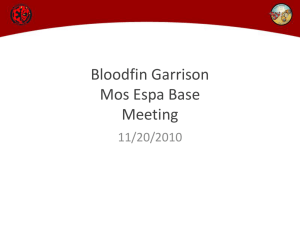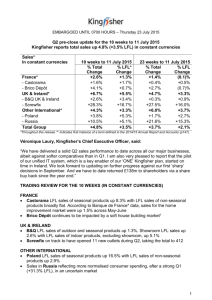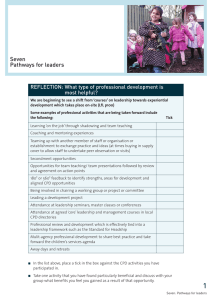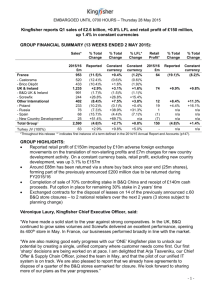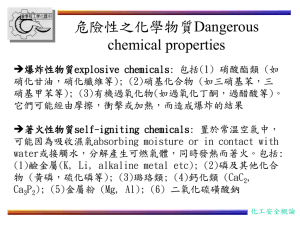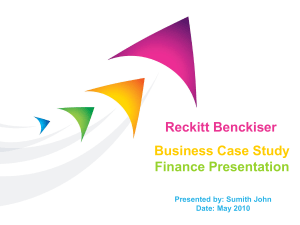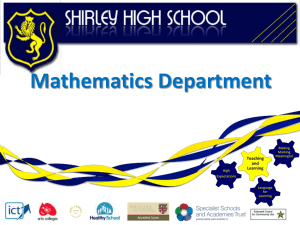Selling the Learning for Life Curriculum
advertisement
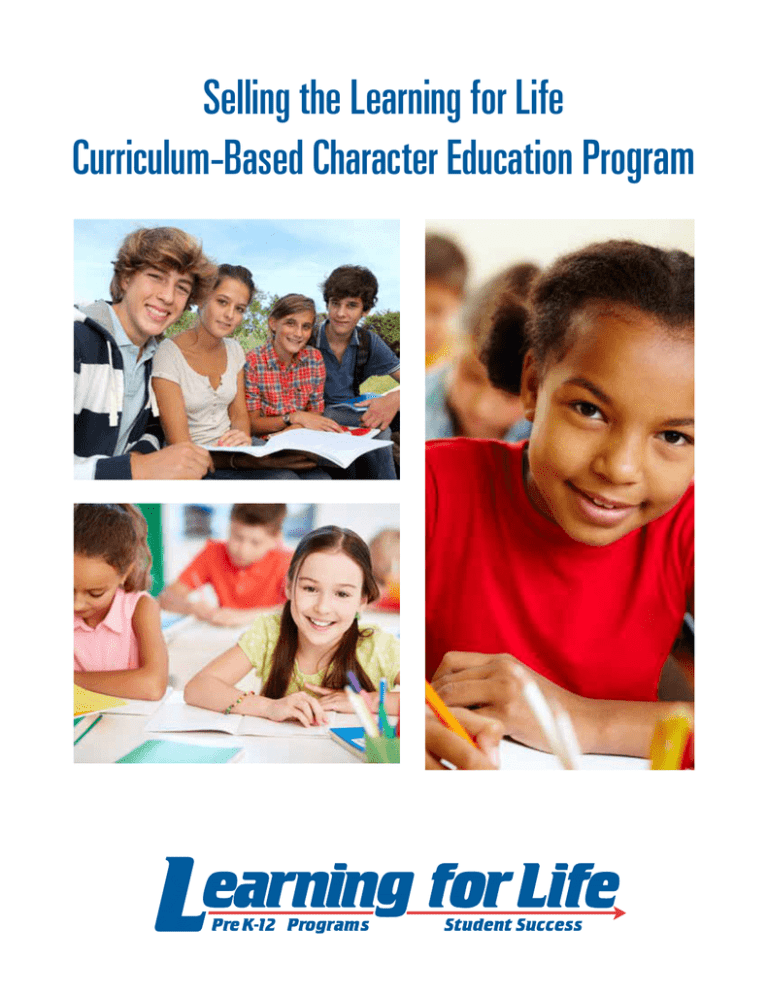
Selling the Learning for Life Curriculum-Based Character Education Program Contents I. What Is Learning for Life?....................................................................................................................................2 II. Selling Learning for Life.......................................................................................................................................2 Components.....................................................................................................................................................2 Features.............................................................................................................................................................3 Selling.................................................................................................................................................................5 III. Glossary................................................................................................................................................................11 1 I. What Is Learning for Life? Learning for Life is a character education program that has been proven to improve a school’s campus culture through the use of flexible, grade-specific lessons and age-appropriate activities for children in pre-K through grade 12. Lessons focus on the following traits: Caring/Fairness Honesty/Trust Respect Citizenship Life Skills Responsibility Courage Perseverance Self-discipline For students with special needs, Learning for Life also has a curriculum that includes basic life skills, coping, and self-sufficiency. Learning for Life is a comprehensive program that reinforces conflict resolution, critical and creative thinking, decision making, social skills, and self-esteem, while providing the authentic practice of curriculum standards. Did You Know? • Learning for Life was incorporated in 1991. • Since its inception, more than 23 million students have participated in LFL school programs. • More than 20,000 schools have used Learning for Life. • Learning for Life is used in all 50 states. Learning for Life provides engaging and relevant solutions for pre-K through grade 12 that are aligned to state and national standards and positively impact academic performance, social and emotional maturity, character development, and career education for all students. Developed by educators and child development experts, Learning for Life has been praised for its ability to involve students through the use of cooperative learning, role playing, small group discussions, and reflective and dilemma exercises. II. Selling Learning for Life Why would a school want or need LFL? Top concerns: Standards, adequate yearly progress, attendance, behavior, bullying, parent involvement, funding What are the components of LFL? A. Character Education (digital) For pre-K–12; provides flexibility by offering multiple ways to present the program, including —Student access from home —Audio support (K–6) —PDFs of all lesson plans, even the ones that aren’t digitized The teacher creates individual student logins. Academic pre/post tests are “test-formatted” (four “reads” with test-formatted questions to assess tested skills—making inferences, cause/effect, details, summarization, etc.). There are 18 to 36 lessons per grade, at a cost of $10 per student. B. Character Education (print) For pre-K–12; common character traits, standards alignment, STEM activities, hands-on activities, trade book/literature correlations, incorporation of multiple modalities, flexibility (multiple ways to present the program), family–home activities, cross-curricular emphasis, integration of academic and character education, and research-based materials. There are 61 lessons ($299 per class). 2 LEARNINGFORLIFE.ORG C. Champions/Special Needs Two programs, one for inclusion students—incorporating social, life, and vocational skills—and one for students in a life skills class—calendar, self-concept, dressing, manners, etc. ($119 per class.) D.Anti-bullying Set of three Web-based videos (for parents, students, and teachers). Each video is 40 minutes (one class period) and can be shown in faculty meetings, classrooms, detention hall, PTA meetings, parent/teacher conferences, etc. Middle school students are predominantly shown, but scenarios are applicable to younger grades. Includes talking points for each video and a lesson plan for the teacher to use when showing the student video to class. All states, except Montana, require public school teachers to have anti-bullying professional development, and these videos meet that criterion. ($249 for a one-year subscription with an annual renewal fee of $249.) E.Prekindergarten Prekindergarten; for use in schools as well as churches, day care centers, and nursery schools—they charge tuition and have money! ($199 per class for one teacher’s guide; no student edition available.) F. Prevention of Substance Abuse Updated in fall 2012; average of 12 lessons per grade level (once or twice a month), written in association with a former police officer who worked with youth drug intervention. This is the perfect option for schools looking for a program similar to DARE. Focus is on healthy habits. Incorporates higher order thinking skills, cooperative learning activities, use of graphic organizers, and family–home activities; incorporates research from NIH (National Institutes of Health) and NIDA (National Institute on Drug Abuse). ($175 for a school set of K–6 teacher guides; no student edition available.) What are the features of LFL? A. How does it work? Lessons consist of three to five activities that do not necessarily need to be done at the same time. With 60 to 71 hard copy lessons and 18 to 36 digital lessons, teachers can present lessons at a specified time (weekly, semiweekly, or biweekly) or when needed—if a situation arises such as cheating, fighting, or disrespect. When using the digital program, students should complete the entire lesson, but it doesn’t have to be in one sitting. Teachers can present the digital, Smart Board–compatible lesson to the class, students can access the lesson on individual classroom computers (for schools with one-to-one computer capability), or students can access the program in a computer lab. Teachers also have the flexibility to choose which activities they would like to do. If working with the whole class, a teacher can combine digital and hard copy activities into the lesson. There are many great hands-on activities (role plays, games, discussions, storybook readings, art activities, etc.) that are not part of the digital program. Digital activities require extended responses from the students and provide them with language arts/creative writing practice. Responses may also be kept in a Learning for Life journal. A teacher could present one lesson from the teacher’s guide throughout the week and then have the students complete the digital version of that lesson at home or in the school computer lab at the end of the week. B. How much time does it take? As much or as little time as needed or desired. The program is extremely flexible. Teachers can present one activity on one day and the second activity on another. Lesson activities can even be incorporated into another lesson plan—such as playing the sixth-grade “Famous People and Their Contributions” concentration game during social studies or reviewing the math problems from the family–home activity in the second-grade “Pet Care” lesson during math class. C. Who teaches the lessons? Lessons may be taught by teachers, counselors, trained parents, volunteers, or staff to fit the needs of each individual school. SELLING THE LEARNING FOR LIFE CURRICULUM-BASED CHARACTER EDUCATION PROGRAM 3 D. Access from Home The digital program is Web-based and may be accessed from home by both teachers and students. E. Common Core State Standards The Learning for Life program for grades 3–8 incorporates many of the English–language arts (ELA) standards within the lessons. Learning for Life lessons enable students to practice the standards on which they will be tested. Many lessons include math, science, and social studies activities that reinforce tested skills. This also applies to six states—Alaska, Indiana, Nebraska, Oklahoma, Texas, and Virginia—and the Commonwealth of Puerto Rico, which have their own standards to which the LFL program is aligned. (A seventh state, Minnesota, has adopted the ELA standards but not those for mathematics.) F. 21st-century Initiatives These are the three R’s (reading, ’riting, ’rithmetic) and four C’s (critical thinking and problem solving; communication; collaboration; and creativity and innovation). Arizona, Illinois, Iowa, Kansas, Kentucky, Louisiana, Maine, Massachusetts, Nevada, New Jersey, North Carolina, Ohio, South Carolina, South Dakota, West Virginia, and Wisconsin have state 21st-century initiatives. These states have designed new standards, assessments, and professional development programs that ensure 21st-century readiness for each student. This requires the governor and chief state education officer to make a commitment by submitting an application describing the state’s plan to integrate the three R’s and four C’s within standards, assessments, and professional development programs. Learning for Life incorporates reading, writing, critical thinking/problem solving, communication, collaboration (partner activities), creativity, and some math skills into most of its lessons. Using Learning for Life in the classroom will help schools in these states meet the requirements for 21st-century learning. G.Recognitions 1. Stickers and charts—Recently updated and available for grades K–6 and Champions. Stickers go on charts that can be posted in the classroom or hallway, or stickers may be given individually to students to put on their binders, folders, etc. 2. Medals—Award of excellence for participation and achievement. 3. Digital certificate—Awarded after completion of all lessons in a module (each individual character trait). Students can print the certificate from their computers. 4. Curriculum-based awards—These include the Classroom Character Education Quality Award; Russell C. Hill Award for outstanding contributions to character education; Vivian Harris Award for outstanding contributions to special-needs programs; National Accreditation Award for Special-Needs Groups; Seventh and Eighth Grade Award of Excellence (requirements include participating in a community service project, researching a famous American, and investigating a career); Character Award of Excellence (requires 50 hours of community service as well as an essay on the importance of good character in daily life); and National Accreditation Award for Senior High Groups. H. Family take-home activities These activities are available with each character education lesson (pre-K–6) and each Prevention of Substance Abuse lesson (K–6). The character-building homework activities reinforce the LFL lesson taught in the classroom and engage parents in their child’s learning. I. Free digital trials Accessed via website or by contacting Angela Sanchez at 972-580-2378 (angela.sanchez@lflmail.org) at the national office. Trials last for two weeks. 4 LEARNINGFORLIFE.ORG Ideas for Prospects Who to Sell To Providing Learning for Life to schools begins with a visit to key decision makers in a school or school district. Every school district is different, so the final decision maker may be different in each situation. Key decision makers typically include superintendents, directors of curriculum, and directors of special needs/special instruction in each school district, as well as principals, guidance counselors, special-needs teachers, school district prekindergarten directors/teachers, and child care center directors. Setting the Appointment—30-second Promotion “I’m in the character education business. I typically work with school principals and superintendents who have problems with low student attendance, are concerned about poor standardized test scores, and are frustrated by spending more time on behavior issues than teaching. Those situations probably don’t happen in your school though, do they?” If the answer is “yes”: “Which one? Why did you pick that one first? Sounds like we should meet and talk about this. How does your schedule look for Tuesday or Wednesday? What’s better for you, morning or afternoon?” If “no”: “I didn’t think so. Could I ask a marketing question? How is the current educational funding debate impacting your students?” If they give a solid answer: “Sounds like we should meet and talk about this. How does your schedule look for Tuesday or Wednesday? What’s better for you, morning or afternoon?” Making the Sales Call The telephone is for scheduling appointments. Sales are best made face-to-face. What to Take With You on the Sales Call • Community leader/volunteer—Leverage connections, relationships, and credibility. • Learning for Life presentation folder—Available from the Supply Group, No. 800-676 • “Prepared especially for” cover page—Templates can be downloaded from the LFL internal website/ Learning for Life/Marketing, and customized for your prospect’s name and organization. • Table of Contents page and sample lesson plans by grade—in Sample Lesson Plans (No. 800-055), available from the Supply Group. Note: The entire book is 62 pages and can be overwhelming on a sales call. Use only the applicable pages for the sales call. Sample lesson plans by grade are also available on the public website at http://learning.learningforlife.org/programs/prek-12-character-ed/. Category Lesson Plan Title Pages Elementary 4 Elementary Substance Abuse Prevention 18 Junior High 23–24 High School 35–36 Special Needs 45 High School Leadership Development 54 SELLING THE LEARNING FOR LIFE CURRICULUM-BASED CHARACTER EDUCATION PROGRAM 5 • Learning for Life Validation Study (No. 610896)—Available from the Supply Group. Highlight improved attendance by one-and-a-half days over students who did not participate in LFL. Attendance figures are often the benchmark by which schools receive funding. Higher attendance rates mean more funding for the school! • Learning for Life Memorandum of Understanding—Found on LFL internal website/Learning for Life/Forms. • Business card—So prospects know how to contact you. • Laptop or iPad—To show digital programs. Places to Start • Public school districts • Catholic school districts • Child care centers (both pre-K and after-school programs) • Goddard schools • Primrose schools • Sylvan learning centers • Huntington learning centers • Kumon math and reading centers • KinderCare learning centers • Learning care (La Petite Academy, Children’s Courtyard, Montessori, Tutor Time) • Head Start Timelines 6 • School budget—When is it created? • Champions are made in the off season—When should you sell to schools? LEARNINGFORLIFE.ORG SELLING THE LEARNING FOR LIFE CURRICULUM-BASED CHARACTER EDUCATION PROGRAM 7 School Budget LFL February March Final draft of budget for next school year reviewed by school board April July September October Fall recruiting (participation season) Renew existing groups (renewal season) Funds made available for the next school year August Train prospective group leaders (participation off season) June December Superintendents, directors of curriculum, and principals determine new courses and programs for next school year November All school districts have slightly different timelines. The above scenario is applicable in most school districts nationwide. School districts develop their budgets for the following school year. When approaching schools regarding LFL programs, follow the school budget cycle and approach school decision makers between November and March in order to have LFL funded in a school budget for the next year. The planning, preparation, and work you invest during the “off season” will result in winning the game during “the season.” Group early renewals (renewal preseason) May Public budget hearing conducted by school board for next school year Prospect and cultivate new groups (participation off season) Curriculum coordinators develop proposed budgets for next school year January LFL and the School Budget Cycle Value-Added Services • Pre/post assessments.There are two types of assessments: academic and character. Academic pre/ post tests are “test-formatted” (four “reads” with test-formatted questions to assess tested skills— making inferences, cause/effect, details, summarization, etc.). The character pre/post tests are exactly the same, so you can determine if a student’s attitudes and feelings have changed after taking the course. The testing can be done electronically with the digital program. Paper tests in the traditional program must be scanned at either the council office or the national office. These are valuable to show program effectiveness and to assist with funding. • Outdoor experiences. Many councils offer an outdoor experience for their students in Learning for Life. Some may call the events Character Camp, Outdoor Adventure Day, Outdoor Challenge Days, Adventure Camp, or other names. Some events are one day and others run multiple days. They are usually staffed by volunteers from civic groups, churches, high school National Honor Society groups, or Scouting leaders. Most conduct activities similar to a Cub Scout day camp. Outdoor experiences such as these provide value to the LFL classroom experience and often are easily funded by local sponsors. • Leadership Development Workshop.This event is designed to teach leadership skills to teenagers in LFL, Exploring, or other teen youth programs. It can be conducted in one day, as an overnight, or as a series of after-school activities. Teen leadership development programs such as this provide value to the LFL classroom experience and often are easily funded by local sponsors. • Career seminars. These are designed to supplement a high school’s career education and can be coordinated at local schools to provide quick insight into a variety of careers. These by no means should be the only Learning for Life feature offered at a school but are merely meant to supplement the LFL high school curriculum, which focuses on career preparation and life skills. A good list of subject matter experts from a variety of careers is beneficial to sustaining career seminars. The seminars provide value to the LFL classroom experience and often are easily funded by local sponsors. Asking Schools to Pay for LFL and Negotiating the Price 8 • What’s my bottom-line break-even point? Before negotiating a price with schools, you need to know your bottom-line break-even point. How much does it actually cost you? Consider the cost of the materials ($5 per book or $4 per digital version), your salary and benefits, and mileage. • Retail Pricing. The Learning for Life public website lists curriculum with a suggested retail price. This is a fairly new concept for Learning for Life. Most councils formerly purchased and sold materials at wholesale cost, thus developing no revenue for council costs to deliver the program. Educators are accustomed to researching curriculum pricing on websites. The national office of Learning for Life receives about a dozen inquiries a week from teachers, guidance counselors, and curriculum directors across the nation interested in the curriculum, anti-bullying, or substance abuse prevention programs. • Print. The suggested retail pricing allows the council to keep $138 (92 percent) for prekindergarten classes, $208 (70 percent) for kindergarten through eighth grade, $188 (95 percent) for high school classes, and $104 (88 percent) for special-needs classes. For more information, go to http://learning. learningforlife.org/digital-programs/school-print/. • Digital. The suggested retail pricing is $10 per student. Of that amount, $6 (60 percent) remains with the council. For more information, go to http://learning.learningforlife.org/digital-programs/school-digital/. • Anti-bullying. The suggested retail price of the video programs is $249 per school campus with 10 percent remaining with the council. For more information, go to http://learning.learningforlife.org/digitalprograms/abc-pricing/. • Prevention of Substance Abuse. The suggested retail pricing is $25 per classroom with $21 (84 percent) remaining with the council. The classroom receives an age-appropriate, grade-specific teacher’s guide. For more information, go to http://learning.learningforlife.org/digital-programs/substance-abuse-prevention/. • Home School. If a home-school family is interested in purchasing the LFL curriculum, the suggested retail price is $49 per student with $43 (88 percent) remaining with the council. For more information, go to http://learning.learningforlife.org/digital-programs/home-print/. LEARNINGFORLIFE.ORG How Do I Ask Schools to Pay? When school principals are approached regarding the Learning for Life program, the typical questions they ask include Who presents the lessons? How much time does it take? What age groups is it for? Why should we use Learning for Life? How much does it cost? It’s this last question that throws people for a loop. Below are suggested responses to the questions most principals ask related to cost. Before anyone says, “Schools don’t have any money,” consider that the Crossroads of America Council serves roughly 100 schools in Learning for Life. The council increased school payments from $774 in 2006 to $22,126 in 2011 by using the techniques below. The Cascade Pacific Council used these techniques for the first time in 2011, and received $15,600 in school payments from 30 schools. 1. How much does it cost? • “Great question. Learning for Life is aligned to the Common Core State Standards Initiative. It’s proven to improve attendance and behavior. Teachers report that it is fun for students and helps them manage day-to-day challenges. So what would a program like that be worth to you per student?” —Listen carefully to their response and value amount. (Most respond between $20 and $50 per student.) • “If I told you it’s $___ per student, how would you feel?” —If they ask more than twice, answer the question directly: “It’s $___ per student.” • If you offer other options, include: —“Additionally, we’ll invite your students to the outdoor activity days we hold in May with horseback riding, archery, cookie decorating, and many more events.” —“We’ll arrange for community business leaders like the police chief, fire chief, county judge, and the president of the hospital to come to speak to your students once a month.” 2. It’s not in our budget. • “But I thought you just said $___ was a good deal?” • “Many schools we work with start with a few classes or just a grade, or sometimes only their students with special needs, then expand to more grades in the future. If you had a program that was proven to increase attendance and improve behavior, with what grade would you look at starting?” (Get their response.) • “How many students are we looking at?” (Get their response.) • “For ___ students, we’re looking in the neighborhood of $___.” 3. We can’t afford it. • “How much can you afford?” • “How much can you afford? Just a ballpark figure—round numbers.” —Get their response. “Round numbers” is less threatening. A typical response is “We could do $6 per student.” If your goal is $12, now you know their budget and can bargain. • Negotiate the price over multiple years. “$6. OK. Do you think you could do $6 this year, $8 next year, $10 the next year, and $12 the year after that?” —Get their response. Typically, “Well, I may not be here then. ...” —“Sure, but do you think whoever IS here could build that into the budget each year?” —If the answer is yes (and it usually is), write down on the Learning for Life Memorandum of Understanding: “2015 = $6; 2016 = $8; 2017 = $10; 2018 = $12” —“Great! Would you mind signing here? It’s just an agreement. Nothing official, just that we initially agree to build this into your budget.” Many will sign. Some will not. 4. We can’t afford that much. • “Did you know that as supplemental education, Learning for Life qualifies for Title I money?” • “I know your school district has a foundation that teachers can apply to for grants for programs like this.” • “Have you thought about IDEA (Individuals with Disabilities Education Act) funding for your students with special needs?” • “Some schools use 21st Century grant money. You might consider that.” SELLING THE LEARNING FOR LIFE CURRICULUM-BASED CHARACTER EDUCATION PROGRAM 9 5. We just don’t have any money. • “I noticed when I walked in the door that you have several school sponsors. With what types of things do they help you?” —Get their response. Typically, they will say their sponsors assist with tutoring or with funding for programs that help students in reading, spelling, and math, or maybe athletic programs. • “So the First State Bank is helping with math tutoring. Why is that?” —Get their response. They may say that teachers are dealing with disciplinary issues and cannot teach everyone or everything. Often teachers spend 80 percent of the time disciplining 20 percent of the students. • “So what I hear you saying is that students have trouble being respectful, which leads to discipline problems, so the teachers are focused on those challenges and do not have time to teach. So that’s causing problems with test scores and is affecting school funding. If we could show you how Learning for Life could improve attitudes toward others and that students pay attention in class so teachers can teach and students can learn, do you think First State Bank would fund that?” 6. Be willing to walk away. • Sometimes the school does not have or is unwilling to invest money to improve attendance and behavior, or they want to have the product for free or for just a few dollars per student. DO NOT GIVE IT AWAY. Be willing to walk away. • “I don’t think this is going to work out right now. When things change for you, let me know and we’ll be happy to work with you.” There will typically be one of two responses: —“OK, thanks.” (Nothing you could ever say or do would change that result, but you have saved yourself time and frustration.) —“Wait, maybe we can come up with more if we did X, Y, and Z. How can we make this work?” (Now you know that they are willing to make a deal.) Other Funding Options (http://learning.learningforlife.org/resources/grants-funding/) • • • 10 Title Funds (http://www.ed.gov/fund/landing.jhtml) —Title I: Created to help low-income or disadvantaged children have the same ability to obtain a high-quality education and be proficient on state academic assessments. Meets needs for lowachieving children in high-poverty schools; children who have limited proficiency in English; migratory children; children with disabilities; Native American children; neglected or delinquent children; and young children in need of reading assistance programs (such as Reading First and Education of Migratory Children), programs for at-risk students, and dropout prevention. Funding goes to schools with the highest percentage of low-income students, with 59 percent going to grades K–5 and 21 percent to grades 6–8. —Title II: Developed to increase student academic achievement by improving teacher and principal quality and increasing the number of highly qualified teachers in the classroom and highly qualified principals and assistant principals in schools; professional development; Enhancing Education through Technology (Ed-Tech). —Title III: Language instruction for LEP (Limited English Proficiency) and immigrant students (closing date is early March). —Title IV: 21st Century Schools; Safe and Drug-Free Schools. —Title V: Innovative programs; public charter/magnet schools; elementary and secondary school counseling; Partnerships in Character Education; development of programs using educational technology, especially in rural and economically distressed areas. —Title VI: All Americans have an equal right under the law to the educational opportunities necessary to achieve the American dream; rural and low-income schools. —Title VII: Education for Native Americans. —Title IX: Education programs and activities available to all students regardless of gender. IDEA (Individuals with Disabilities Education Act, http://idea.ed.gov)—Early intervention; special education. REAP (Rural Education Achievement Program, http://www2.ed.gov/nclb/freedom/local/reap.html)— Meets the needs of small, rural schools that do not qualify for funds that go to larger schools. Sponsors—Neighborhood businesses that partner with schools; corporations willing to donate to community or to ensure education of future employees; PTA/PTO; service organizations (e.g., Kiwanis, Lions Club, Rotary, Elks). LEARNINGFORLIFE.ORG • Grants/Foundations—Before- and after-school programs such as 21st Century Community Learning Centers; Daniels Fund (Colorado, New Mexico, Utah, and Wyoming); state incentive grants; United Way; school district foundations; public/private foundations; federal grants. • Other: Adopt-a-school programs; chambers of commerce. Required Paperwork • Memorandum of Understanding (MOU)—A mutual agreement between two parties indicating an intended common line of action. This is not a legally binding agreement. III. Glossary ADA (average daily attendance)—The total number of days of student attendance divided by the total number of days in the regular school year. A student attending every day would equal one ADA unit. ADA is not the same as enrollment, which is the number of students enrolled in each school and district. (Enrollment is determined by counting students on a given day in October.) ADA usually is lower than enrollment due to factors such as students moving, dropping out, or staying home due to illness. The state uses a school district’s ADA to determine its general purpose (revenue limit) funding and some other funding. It is important for you to know how dollars are allocated. LFL has been proved to increase attendance, which means more dollars for schools. AYP (adequate yearly progress)—This is part of the No Child Left Behind Act of 2001. Its goal is to strengthen educational quality in schools. Students must demonstrate AYP in reading and language arts, and mathematics. Schools must also meet specific graduation rates (high schools) or attendance rates (elementary and middle schools). To make AYP, a school must test 95 percent of its students who belong to one of eight different subgroups (special education, English-language learners, low-income, or from five major racial/ethnic groups), and 95 percent of those students must meet the minimum standards. Schools that do not meet AYP for two consecutive years are placed on “School Choice” status, meaning that students can choose to go to another public school and the district must provide transportation. The district must use Title I funds for professional development of teachers and tutoring or for after-school programs from a state-approved provider. Private schools do not need to meet AYP. Learning for Life’s digital curriculum meets the needs of students who learn best using computers. Use of LFL improves classroom behavior so that all children have a better learning environment and want to come to school. Campus improvement plan—Also called a “site-based improvement plan.” The premise is that the most effective decisions are made by those who will implement them. Schools identify problems, develop problem resolutions, and change strategy. The plan is usually for one year. The objective is to improve student performance and enhance accountability. You need to research the CIPs in your schools to determine how the Learning for Life curriculum can help meet their needs. Common Core State Standards Initiative (CCSS, www.corestandards.org)—National academic standards for English–language arts (ELA) and mathematics. CCSS is not used in Alaska, Indiana, Nebraska, Oklahoma, Texas, and Virginia—which adhere to their own state standards—and the Commonwealth of Puerto Rico. Minnesota has adopted the ELA standards but not those for mathematics. Testing begins in third grade and continues through 12th grade. Developed to meet the expectations for college readiness. There is a strong focus on the use of literary nonfiction, which is prevalent in the Learning for Life curriculum. The LFL program is aligned to the Common Core ELA standards in grades K–8 and math standards in K–5. Critical thinking—Students are taught to “think critically.” This includes reflection on a text to determine understanding, looking at details to gather information, understanding the main idea, questioning, providing supporting evidence, and recall of details. This is done in classrooms through higher-order questioning. The Learning for Life digital curriculum has embedded higher-order thinking skills, and the revised teacher’s guides will incorporate this strategy as well as more collaborative learning opportunities that also enhance critical thinking. Early Childhood—Prekindergarten. Learning for Life has an outstanding pre-K program. Note that this program is not in a digital format. E-learning—Electronically supported learning such as that offered by Learning for Life. SELLING THE LEARNING FOR LIFE CURRICULUM-BASED CHARACTER EDUCATION PROGRAM 11 ESL/ELL (English as a second language/English-language learners)—Learning for Life family–home activities are available in Spanish. Free/reduced-price lunch program—Children from families with incomes at or below 130 percent of the poverty level are eligible for free meals. Those families with incomes between 130 percent and 185 percent of the poverty level are eligible for reduced-price meals, for which students can be charged no more than 40 cents. (For the period July 1, 2014, through June 30, 2015, 130 percent of the poverty level is $31,005 for a family of four; 185 percent is $44,123.) IEP (Individualized Education Program)—Mandated by the Individuals with Disabilities Education Act, IEPs have been developed to help students with disabilities reach educational goals. The evaluation process and discussions with teachers help to improve understanding of the disability, how it affects learning, and how the individual student can best learn. The use of technology such as that offered by Learning for Life is often suggested for students with IEPs. The Learning for Life curriculum can also help students to appreciate each other and respect individual differences. The program can improve classroom behavior, which provides all students with a better learning environment. The hands-on activities often help students with a special-needs focus. Integrative learning—Making connections across subjects in a curriculum, more commonly known as “integrated curriculum.” Learning for Life curriculum is designed to meet the needs of the whole child and takes into account the different learning styles of students as it integrates math, language arts, history, science, and technology. There is currently a big push for this learning strategy. Studies prove that the more students can make connections in their learning, the deeper their understanding of the concepts. Mainstreaming—This term and the term “inclusion” are not interchangeable. Mainstreamed students are mildly disabled at their expected grade level, but they have the same outcomes as other students. The outcomes for inclusion students are developed in an IEP (see above) with a high emphasis on social outcomes. The Learning for Life digital curriculum is masked so that students in the same classroom will not know which grade level the others are working in. NCLB (No Child Left Behind)—Also known as ESEA (Elementary and Secondary Education Act). This includes Title I, and supports standards-based education on the premise that setting high standards will improve educational outcomes. States are required to assess basic skills (ELA and math). What has this done to education? It holds teachers responsible for the improvement of student test scores. The yearly tests determine funding allocations. All Learning for Life lessons incorporate reading and basic skills to support standards-based education. For more information, visit www2.ed.gov/nclb/landing.jhtml. NSFA (National School Foundation Association)—This organization encourages school districts to establish, develop, and maintain school foundations. For example, the Plano (Texas) ISD Education Foundation awarded $100,000 in grants donated by sponsors (Park Place Lexus, Huawei, Plano ISD Council of PTAs, and Alliance Data). The district has raised almost $8 million to benefit Plano schools during the past 19 years. The Plano ISD Education Foundation is a nonprofit organization that funds priority programs identified by the school district for which tax dollars are not available. Visit www.schoolfoundations.org to see if your local districts have a school district foundation. Race to the Top—Competitive grants awarded to states or districts that are creating conditions for educational innovation and reform, improving student achievement and graduation rates, and ensuring college success. For example, in 2012, schools in Miami, Florida, were awarded $30 million to put a math center in every middle school. Other districts that were awarded money included one that was expanding technology. Visit www2. ed.gov/programs/racetothetop for more information. 12 LEARNINGFORLIFE.ORG Special Needs • ADHD (Attention deficit hyperactivity disorder)—These students qualify for special help in schools (Section 504 of the Vocational Rehabilitation Act of 1973 and IDEA). Many ADHD students respond well when using computers for learning. • Autism—Occurs four times more often in boys than in girls. This is a qualifying condition for IDEA dollars. The social skills taught in the Learning for Life program can benefit autistic students. • Dyslexia—Characterized by number and letter reversals and an inability to write correctly. Copying from the board is difficult, and children have difficulty remembering what has been said. Using the LFL digital program enables dyslexic students to respond without having to write their answers and to replay the audio embedded in the lesson. • ED (emotional disturbance)—An inability to build or maintain relationships; inappropriate behaviors. Students with emotional issues often thrive when working individually (as on computers). This helps them to feel successful and more competent, and they may seek friends with similar interests. The Learning for Life curriculum teaches about building relationships and working with others. • DD (developmentally disabled)—A person with a substantial physical or mental disability. State standards—Applicable only to states not using the Common Core State Standards (Alaska, Indiana, Nebraska, Oklahoma, Texas, and Virginia). Minnesota has adopted the CCSS English–language arts standards but not those for mathematics. Please refer to state websites for information; find standards alignment for these states on the LFL website. STEM—Acronym for “science, technology, engineering, and math.” There is currently a big push in education to teach these skills to students of all ages. STEM education plays a critical role in enabling the United States to remain the economic and technological leader of the global marketplace in the 21st century. There are many corporations willing to finance STEM initiatives and programs in schools. The goal is to inspire students to pursue careers in STEM fields. Learning for Life’s digital curriculum certainly incorporates the “technology” aspect of STEM. Many LFL lessons have science and math activities. LFL even offers a few engineering activities (building a flying propeller in first grade, stacking blocks in kindergarten). We are incorporating more STEM activities as we update the teacher’s guides, and the new editions will include a STEM logo next to STEM-related activities. 21st-century learning skills—Just as schools in the 19th century were designed to prepare students for work and life in an industrial economy, today we need to meet the demands of a changing world that has been transformed by technological advances, a global economy, and environmental changes. Skills to be taught include media literacy, information literacy, and information and communications technology; critical thinking and systems thinking; problem identification and solution; creativity; intellectual curiosity; flexibility and adaptability; initiative; self-direction; social and cross-cultural skills; productivity; accountability; leadership; and responsibility. The Learning for Life curriculum incorporates many of these skills for both teachers and students. Virtual learning environment/learning management system (LMS)—A learning platform that delivers a student– centric learning experience by bringing together educational theory and practice, technology, and content. It is an online program that provides teachers, students, and parents the tools and resources to support and enhance the education of students. The Learning for Life digital program is an LMS. Photo Credits Shutterstock.com, courtesy— front cover (top left, ©Goodluz/ Shutterstock; right and bottom left, ©Pressmaster/Shutterstock) SELLING THE LEARNING FOR LIFE CURRICULUM-BASED CHARACTER EDUCATION PROGRAM 13 LEARNING FOR LIFE 1329 West Walnut Hill Lane P.O. Box 152225 Irving, TX 75015-2225 http://www.learningforlife.org 800-776 2015 Printing
